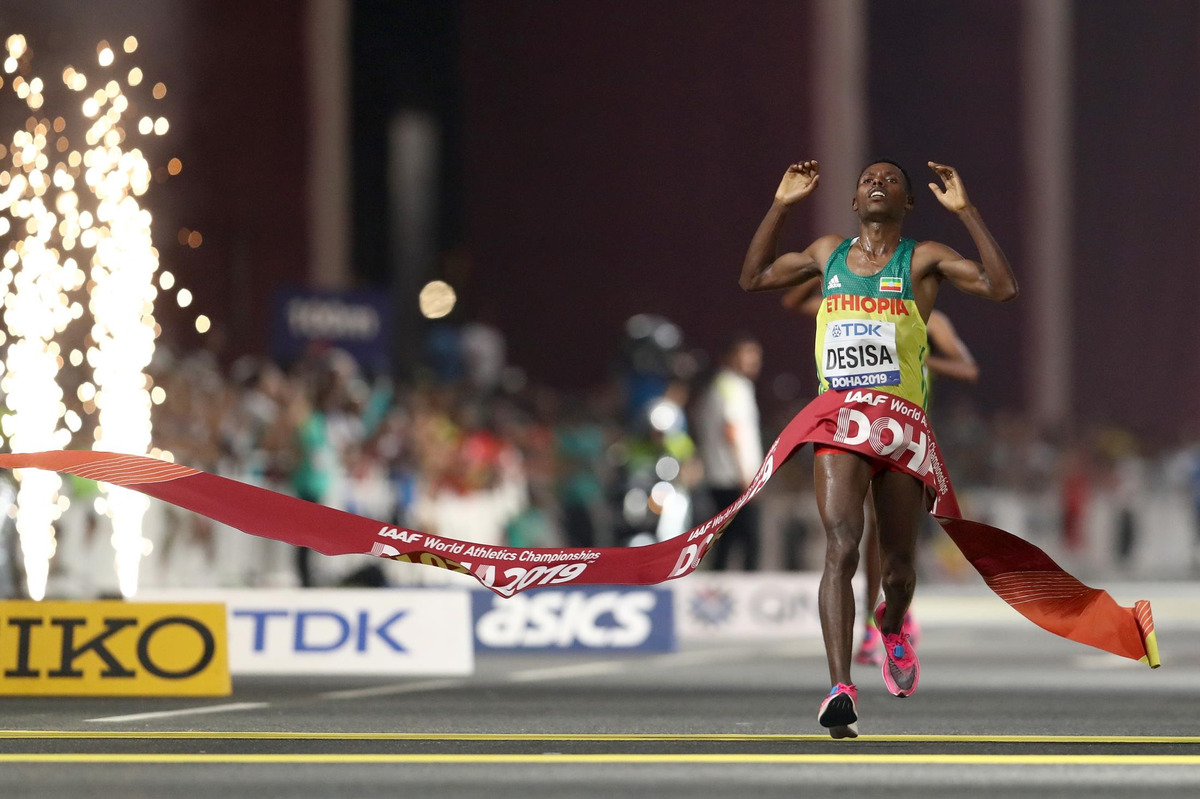

Featured
How Many Meters In A Marathon Row
Modified: January 2, 2024
Find out how many meters are in a marathon row with our featured guide. Discover the distance of this challenging endurance activity.
Introduction
Welcome to the world of marathon rowing, where endurance and perseverance are put to the test. If you’ve ever wondered how many meters are in a marathon row or if you’re considering taking on this challenging feat, you’ve come to the right place.
A marathon row refers to the act of rowing a distance equivalent to that of a marathon race. While the standard distance of a marathon run is 42.195 kilometers (26.2 miles), a marathon row typically covers a distance of 42,195 meters. This grueling endeavor pushes rowers to their limits, both physically and mentally.
To put it into perspective, imagine rowing the length of a standard Olympic-size swimming pool over 1,678 times! It requires incredible strength, stamina, and determination to complete such a long distance on a rowing machine or in a rowing boat.
Now that we have a clear understanding of what a marathon row entails, let’s explore more about this challenge and how it can be approached. Whether you’re a seasoned rower looking to tackle the ultimate endurance test or a beginner seeking inspiration, this article will provide you with insights and tips to make your marathon rowing journey a success.
Definition of a Marathon Row
A marathon row is a long-distance rowing challenge that involves covering a distance of 42,195 meters, typically equivalent to the distance of a marathon race. This test of endurance can be completed on a rowing machine or out on the water in a rowing boat, where participants aim to row the entire distance without stopping.
Marathon rowing can be a solitary endeavor or a team effort, depending on the preferences and goals of the participants. Solo rowers often aim to complete the distance within a specific time frame, pushing themselves to their limits. Team events, on the other hand, involve multiple rowers taking turns to cover the distance collectively.
The duration of a marathon row can vary significantly depending on individual rowing speed, fitness level, and technique. Elite rowers may complete a marathon row in under three hours, while recreational rowers may take anywhere from four to six hours or more to finish. Patience and mental endurance are crucial during this long-lasting physical challenge.
Marathon rowing is not just about completing the distance; it also involves strategizing pacing, technique, and maintaining proper form throughout the row. It’s essential to strike a balance between rowing at a challenging pace and conserving energy to last the entire distance. Successful marathon rowers employ efficient rowing techniques like a strong leg drive, steady rhythm, and controlled breathing to maximize their performance.
A marathon row pushes the physical and mental limits of the participants, requiring immense strength, stamina, and determination. It tests not only the rowers’ physical endurance but also their mental fortitude and ability to push through fatigue and discomfort.
Now that we have a solid understanding of what a marathon row entails, let’s explore how to convert meters into other commonly used units and train effectively for this demanding challenge.
Conversion of Meters to Other Units
While marathon rowing is typically measured in meters, it can be helpful to understand the equivalent distances in other commonly used units. This knowledge can make it easier to conceptualize the distance and set goals during training. Here are the conversions for the distance of 42,195 meters, which is the standard length of a marathon row:
- 42,195 meters is approximately 26.2 miles. This is the same distance covered in a traditional marathon run.
- In kilometers, 42,195 meters is exactly equivalent to 42.195 kilometers, which is the same distance covered in a marathon run.
- When converted to yards, 42,195 meters is approximately 46,193 yards.
- Finally, in feet, 42,195 meters is approximately 138,354 feet.
Understanding these conversions allows rowers to gauge their progress and set milestones during their training. Breaking down the distance into smaller increments and linking them to these familiar units can make the goal of completing a marathon row more tangible and achievable.
During training, rowers often track their progress using the meters displayed on the rowing machine or distance-tracking devices. However, being aware of these additional unit conversions can provide a different perspective and motivate rowers to reach significant markers along the way.
Now that we have a solid understanding of the conversions for a marathon row, let’s delve into effective training strategies to prepare for this endurance challenge.
Training for a Marathon Row
Preparing for a marathon row requires a well-structured and progressive training plan. Building endurance, strength, and mental resilience are key components of successful marathon row training. Here are some strategies and tips to help you prepare:
- Start with a Solid Foundation: Before diving into marathon row training, ensure that your basic rowing technique is strong. Focus on mastering proper rowing form, including a strong leg drive, controlled upper body movement, and efficient use of your core muscles. A solid foundation will help prevent injuries and lay the groundwork for more advanced training.
- Gradually Increase Distances: Begin your training by gradually increasing the distances you row. Start with shorter distances and gradually build up to longer distances as you build endurance. This progressive approach allows your body to adapt and reduces the risk of overuse injuries.
- Mix Up Your Training: Vary your training sessions to incorporate different intensities and rowing techniques. Include steady-state rowing for building endurance, interval training for improving speed and power, and recovery sessions for active recovery. Mixing up your training not only keeps things interesting but also helps prevent plateauing and maximizes your overall fitness.
- Mental Preparation: Marathon rowing can be mentally challenging, especially during the later stages when fatigue sets in. Practice mental techniques such as visualization, positive self-talk, and goal-setting to stay focused and motivated during the long row. Develop a strategy for pacing yourself and breaking the distance into smaller goals to stay motivated throughout.
- Strength Training: Incorporate strength training exercises into your routine to build overall body strength. Focus on exercises that target the muscles used during rowing, such as squats, lunges, deadlifts, and rows. A strong and balanced physique will enhance your rowing performance and help prevent muscle imbalances.
- Rest and Recovery: Listen to your body and prioritize rest and recovery. Allow for adequate rest days in your training schedule to allow your muscles to repair and rebuild. Incorporate stretching, foam rolling, and other recovery techniques to minimize muscle soreness and prevent injuries.
Remember, consistency and gradual progression are key in marathon row training. It’s important to have a training plan tailored to your current fitness level and gradually increase the intensity and duration of your workouts over time. Don’t forget to fuel your body with proper nutrition and hydrate well to support your training and aid in recovery.
By following these training strategies, you’ll be well-prepared to take on the challenges of a marathon row and have a successful and fulfilling experience.
Benefits of Marathon Rowing
Engaging in marathon rowing offers a wide range of physical, mental, and overall health benefits. Let’s explore some of the key advantages of undertaking this endurance challenge:
- Cardiovascular Fitness: Marathon rowing is a highly effective cardiovascular workout that significantly improves heart and lung health. The sustained effort required during a marathon row strengthens the cardiovascular system, increases lung capacity, and enhances overall endurance.
- Full-Body Workout: Rowing engages muscles throughout the entire body, providing a comprehensive full-body workout. It targets the legs, back, core, arms, and shoulders, helping to build strength, increase muscle tone, and improve overall body composition.
- Low-Impact Exercise: One of the major advantages of rowing is that it is a low-impact exercise, putting less stress on the joints compared to activities like running or high-intensity interval training. This makes marathon rowing a suitable option for individuals with joint issues or those looking to minimize impact on their bodies.
- Mental Resilience: Completing a marathon row requires mental fortitude and resilience. The mental grit developed during training and the race itself can transfer to other areas of life, enhancing resilience, discipline, and the ability to overcome challenges.
- Weight Management: Regular participation in marathon rowing can contribute to weight management and fat loss. Rowing burns calories at a high rate, making it an effective way to expend energy and create an energy deficit for weight loss or maintenance.
- Stress Reduction: Rowing, like any form of exercise, stimulates the release of endorphins, also known as the “feel-good” hormones. This can help reduce stress levels, elevate mood, and promote a sense of well-being.
Beyond the physical and mental benefits, marathon rowing also offers a sense of accomplishment and personal achievement. Crossing the finish line of a marathon row, whether in a race or during a personal challenge, instills confidence, boosts self-esteem, and provides a lasting sense of pride.
It’s important to note that the benefits of marathon rowing can be experienced by individuals of all fitness levels. Whether you’re a seasoned athlete or just starting your fitness journey, incorporating marathon rowing into your routine can yield remarkable improvements in both physical and mental wellness.
Now that we’ve explored the benefits of marathon rowing, let’s move on to some valuable tips to help you successfully complete a marathon row and make the experience enjoyable and rewarding.
Tips for Completing a Marathon Row
Completing a marathon row is a significant accomplishment that requires careful planning and execution. Here are some valuable tips to help you successfully complete your marathon row:
- Set Realistic Goals: Before beginning your marathon row, set realistic goals based on your fitness level and training progress. Break down the distance into smaller milestones and focus on achieving one milestone at a time, rather than getting overwhelmed by the entire distance.
- Pace Yourself: Conserving energy is crucial for a marathon row. Start with a comfortable pace and gradually increase your effort as you progress through the row. Avoid starting too fast, as this can lead to early fatigue and burnout.
- Stay Hydrated and Nourished: Proper hydration and nutrition play a significant role in your performance during a marathon row. Stay hydrated by drinking water regularly and consider electrolyte-replenishing drinks for longer rows. Fuel your body with balanced meals and snacks before and during the row to maintain energy levels.
- Maintain Proper Form: Focus on maintaining proper rowing form throughout the entire row. This includes maintaining a strong leg drive, leaning back slightly at the finish, and keeping a controlled, smooth rhythm. Good form helps optimize your efficiency and reduces the risk of injury.
- Take Short Breaks (If Needed): If you’re tackling the marathon row alone, it’s okay to take short breaks when necessary. Use these breaks to stretch, hydrate, and mentally reset before continuing. Just be mindful not to take too many breaks that interrupt your overall momentum.
- Find Motivation: Keep yourself motivated during the marathon row by finding what works best for you. Play energizing music, listen to podcasts or audiobooks, or visualize crossing the finish line at the end. Surround yourself with positive and supportive people who will cheer you along the way.
- Mental Strategies: Mental resilience is vital for completing a marathon row. Break the distance into smaller segments and focus on one segment at a time. Use positive self-talk, visualization, and mentally rehearse your strategy to overcome any challenges you may face.
- Enjoy the Journey: Marathon rowing is an endurance test, but it’s also an opportunity to enjoy the experience. Embrace the challenge, appreciate the progress you’re making, and recognize the incredible feat you’re accomplishing. Celebrate every milestone as you work your way towards the finish line.
Remember, completing a marathon row is about more than just reaching the finish line. It’s about the journey, the personal growth, and the challenges you overcome along the way. Stay committed, stay focused, and believe in your ability to achieve this remarkable accomplishment.
Now that you have these tips in mind, you’re ready to take on the challenge and successfully complete your marathon row!
Conclusion
Embarking on a marathon row is no small feat, requiring physical endurance, mental resilience, and meticulous preparation. Throughout this article, we’ve explored the definition of a marathon row, conversions to other units, training strategies, benefits, and tips for successfully completing this demanding challenge.
Marathon rowing offers numerous benefits, including improved cardiovascular fitness, a full-body workout, low-impact exercise, mental resilience, weight management, and stress reduction. By following a well-structured training plan, gradually increasing distances, and incorporating strength training, rowers can develop the physical and mental capacity needed for a marathon row.
Setting realistic goals, pacing oneself, staying hydrated and nourished, maintaining proper form, and employing mental strategies are key to completing a marathon row. Taking short breaks (if needed), finding motivation, and enjoying the journey along the way also contribute to a successful and fulfilling experience.
Whether you’re a seasoned rower seeking the ultimate endurance challenge or a beginner looking to push your limits, a marathon row offers an opportunity to surpass your own expectations, build resilience, and achieve a remarkable accomplishment. The sense of pride, personal growth, and accomplishment that comes with completing a marathon row is truly unparalleled.
So, lace up your rowing shoes, grab your oars, and embrace the journey of marathon rowing. Train hard, stay focused, and remember to enjoy the process. With determination, perseverance, and the tips shared in this article, you’ll be well-equipped to conquer the distance and stand proud as a marathon rower.









